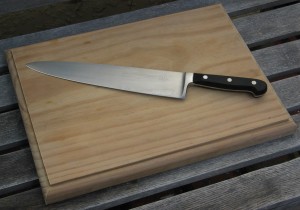Miss Thrifty8 October 29, 2008
For one reason and another I’ve ended up with nine wooden chopping boards, which works out at four-and-a-half chopping boards per member of my household. I only went out and bought one of them (the first one) but I’m a kitchenware geek – and the people who buy me presents know the way to my heart.
I doubt I’ll ever need to buy another chopping board as long as I live, because all my boards are in tip-top condition. This is what I have learned:
- Don’t buy those boards that are made up of compressed and glued sections of smaller pieces of wood. They may look good, but they are more likely to crack. A board cut from a single piece of wood is far sturdier. It’s probably cheaper, too.
- Go as thick as you can. Yes, the thinner boards are more economical – but they’re flimsier, too. The blocky ones are better value for money, in the long run.
- Never put your chopping board in the dishwasher, or leave it submerged in soapy water. Not that you’d do this anyway; as a reader of this blog you are evidently blessed with the highest quality brain cells. I’m just sayin’.
- Okay, this is an important one. Oil your board on a regular basis: every four weeks should do. Boards crack because over time, they dry out. Keep them moisturised, and they’ll go on and on and on. Just spill a little bit on, and rub it over and into the board with kitchen paper or a clean cloth.
- Don’t do this with cooking oil, though. It may cost next to nothing, but those vegetable oils go rancid over time. IKEA does a chopping board oil for £4.99, but I’d avoid that too. It’s mostly made up of linseed (i.e. vegetable) oil. I love linseed oil because you can use it for loads of things – like keeping leather sofas soft – but sloshing it around food preparation surfaces isn’t one of them. You want food grade mineral oil, also known as butcher’s block oil. The bottles that I have found all come in around the £4-£5 mark: you can pick them up at any hardware store, or order online.
Easy peasy!

8 Responses to “Stop your wooden chopping boards from cracking – in 5 easy steps”
sharon rose says:
Hi there-great tips, especially about the oil usage!
October 30, 2008 at 10:15 am
MJ Ray says:
No butcher’s block oil listed on the linked web page. Got another good source?
December 30, 2008 at 4:58 pm
admin says:
Hi MJ – try this one.
http://www.headcook.co.uk/catskill-craftsmen-butchers-block-p-2806.html
It’s £5.50, but I’ve used it and it’s good.
Best wishes,
Miss T.
December 31, 2008 at 2:31 am
MJ Ray says:
Thanks – ordered some! Given how popular butchers blocks seem to be, I’m surprised the oils don’t seem to be in High Street stores.
December 31, 2008 at 11:13 am
admin says:
Yeah – me too! Some people use olive oil / cooking oil, which is cheaper and readily available, but turns rancid over time. I only know this because I met the MD of a chopping board company (a very niche meeting!) a few years back and he practically grabbed me by the shoulders and made me promise that I would never, ever abuse my boards in such a fashion. Kitchenware geeks rule!
– Miss T.
January 3, 2009 at 12:38 am
Chrissie B says:
‘Food grade mineral oil’ is liquid parafin – it’s much cheaper from your local chemist (pharmacist) – about £1.95 a 500ml bottle. I use it all the time for the chopping boards I make and sell.
December 5, 2009 at 7:25 pm
Tina says:
All the products on http://www.foodsafeoils.com are foodsafe, odourless, colourless and tasteless, so perfect for all wooden boards.
These products are also nut free and vegan.
A perfect solution of any wooden butchers block, chopping board, cheese board, salad bowl and utensils…. no more nasty linseed, just beautiful conditioned wood.
January 7, 2010 at 9:10 pm
Andy says:
Ikea chopping board is not linseed oil but is in fact white mineral oil, the same or similar to liquid paraffin.
July 20, 2016 at 12:46 am